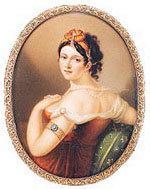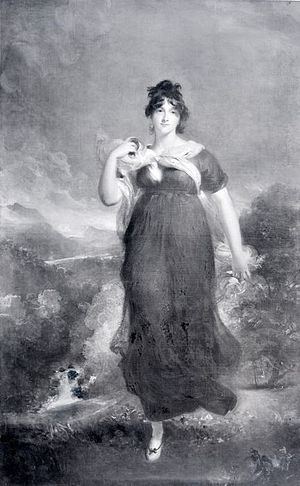Name Elizabeth Marchioness | Parents Joseph Denison | |
 | ||
Died October 11, 1861, Patrixbourne, United Kingdom Spouse Henry Conyngham, 1st Marquess Conyngham (m. 1794) | ||
Elizabeth Conyngham (née Denison), Marchioness Conyngham (31 July 1769 – 11 October 1861), was an English courtier and noblewoman. She was the last mistress of George IV of the United Kingdom.
Contents

Early life
She was born in 1769. Her father was Joseph Denison, owner of the Denbies estate in Surrey, who had made a fortune in banking. Her mother was Elizabeth Butler. On 5 July 1794, Elizabeth married Henry Conyngham, Viscount Conyngham, an Irish peer. Despite her beauty, she was considered vulgar, shrewd, greedy, and unsuited to aristocratic society, on account of her common background; however, she attracted lovers and admirers, including the Tsarevitch of Russia, the future Nicholas I.
Royal mistress
The Conynghams were not well-connected, and according to the Duke of Wellington, Elizabeth decided as early as 1806 to become a mistress of the Prince of Wales, the future King George IV. She probably became his lover in 1819, when the Prince was Prince Regent, but finally supplanted her predecessor, Isabella Seymour-Conway, Marchioness of Hertford after he became king in 1820. He became besotted with her, constantly "kissing her hand with a look of most devoted submission", and while his wife, Caroline of Brunswick, was on her divorce "trial", the king could not be seen with Lady Conyngham, and was consequently "bored and lonely". During the Coronation, George was constantly seen "nodding and winking" at her.
Lady Conyngham's liaison with the King benefited her family. Her husband was raised to the rank of a marquess in the Peerage of the United Kingdom, and sworn to the Privy Council, in the Coronation honours of 1821. He was also given several other offices, including Lord Steward of the Household and the Lieutenantcy of Windsor Castle. Her second son was Master of the Robes and First Groom of the Chamber.
Lady Conyngham had Whiggish sympathies, but was not concerned with political ambition; she concentrated on furthering the financial position of her family. However, when she requested that her son's tutor be made Canon of St. George's Chapel, Windsor, the Prime Minister, Lord Liverpool threatened to resign. Arguments with Lady Castlereagh further worsened the relationship between the King and government. She also disliked the Keeper of the Privy Purse, Benjamin Bloomfield, and was successful in having him removed in 1822. His successor, William Knighton, was a close friend of the King, who successfully cleared all his debts later in his reign. Dorothea Lieven dismissed her with contempt as having " not an idea in her head...not a word to say for herself..nothing but a hand to accept pearls and diamonds, and an enormous balcony to wear them on."
Later life and death
As his life progressed, the King became dependent on Lady Conyngham on account of his temper and poor health. However weary she became of his company, his affection for her never ceased. The relationship came to an end with George's sudden death in 1830; she immediately moved from Windsor Castle to Paris. Although the King had bequeathed her all his plate and jewels, she refused the entire legacy. The Marquess broke his staff of office at George's funeral, and was never to hold another one in the next reign. Lady Conyngham lived until 1861, dying near Canterbury at the age of 92. Although excluded from court during the reigns of King William IV and Queen Victoria, her son, Francis Conyngham, 2nd Marquess Conyngham, was Lord Chamberlain to William, and, along with the Archbishop of Canterbury, brought the news of William's death to Princess Victoria, and first addressed her Your Majesty. The 2nd Marquess's daughter, Jane Churchill, was later a Lady of the Bedchamber to Queen Victoria and one of her closest friends.
